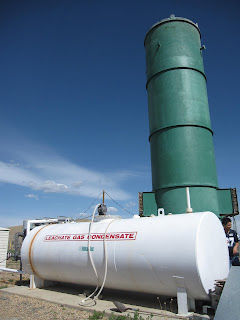

In order to talk about food and especially when it comes to improving our food systems, we have to address waste as well. Recently, I took a field trip to the Denver Regional Landfill, Western Disposal and Eco-cycle. Sure, I would have eventually gone on my own, but instead, escorted a busload of middle school kids who would rather, at any cost, talk about sex, than investigate garbage--I cannot blame them. However, the kids and I would probably agree that a bad day at the dump is better than a good day at the school and even though this was a math field trip (using very little math), we all learned a little something a
 bout waste.
bout waste.Stopping first at a giant green tube that had a mirage floating above it, an engineer who works at the landfill, described how it works. Every proper (as in, legal) landfill in the US starts by digging a giant hole, lining it with clay and then plastic. Once you have a lined hole in the ground, you can start throwing garbage into it. As the garbage settles, the ground sinks, you bury the old garbage, then throw more garbage on top of that. Over time, a methane-filled liquid sludge settles on the bottom of the garbage hole. It is piped out through a well, stored in a tank and then burned to "reduce greenhouse gas emissions." Beginning in October, a month after this landfill closes for good, the methane will start being pumped to a combustion engine. This engine will power a wind turbine that will feed energy back to the grid. After asking the engineer what the by-product of burning methane is, he told me CO2. Isn't CO2 a greenhouse gas--the gas that most scientist agree is THE bane of all evil in our modern, toxic world? The engineer assured me that methane, which breaks apart our ozone layer, is much worse than CO2. Hmmm, the garbage problem we face is bigger and more complex than meets the eye. This landfill receives 8 MILLION POUNDS OF TRASH PER DAY. Of this, 60% is paper, 15% is plastic--in other words 85% of the garbage could be recycled. This dump has a lifespan of 31 years and the owner (oh yeah, private owners make a killing off of their landfills) is responsible for the dump 30 years after it closes.
Next we would drive to the Western Disposal which is the transfer center for Boulder's garbage. Here we got a close up look at a Boulder's garbage being loaded onto the truck. The kids were psyched at the quality of things thrown into the piles and if the site's supervisor hadn't been present, they would have been foraging through the piles. One of my students found a tennis racket and another was pretty happy about taking home a piece of rebar--whatever makes you happy, you know? Western Disposal also has a winning compost program. Residents have special bins at their house to throw food and yard waste scraps into. Once at Western's site the contents of those yard and food waste bins are turned into compost and that is sold back to the public.
Our last and final stop was Eco-cycle recycling center where we got a chance to see how recyclables are processed for our county. We are lucky to have a single stream recycling where all recyclables go into one bin and people and machines sort the goods at the plant. After the plastic, glass, metals and paper stop here, they are sold to places that up-cycle them into new materials like the counter-top and bathroom stalls pictured below.
 Now, if we could just figure out how to get the 85% of garbage that is not being recycled into our recycling centers we might have a standing chance at a future with 7 million people on the planet. But then, there is still the environmental degradation of mining for these goods to begin with and the toxic chemicals used to produce and reproduce goods. More on that later.
Now, if we could just figure out how to get the 85% of garbage that is not being recycled into our recycling centers we might have a standing chance at a future with 7 million people on the planet. But then, there is still the environmental degradation of mining for these goods to begin with and the toxic chemicals used to produce and reproduce goods. More on that later.
Nice blog. This is such an important topic. We produce so much garbage without a second thought. I made a goal last month to avoid all food wrapped in plastic for 3 days - it was extremely difficult....back to the bulk bins.
ReplyDeleteThanks Ryan, I'm glad you like it! We all need more challenges like
ReplyDeleteyour 3 day plastic challenge to hit home the point.